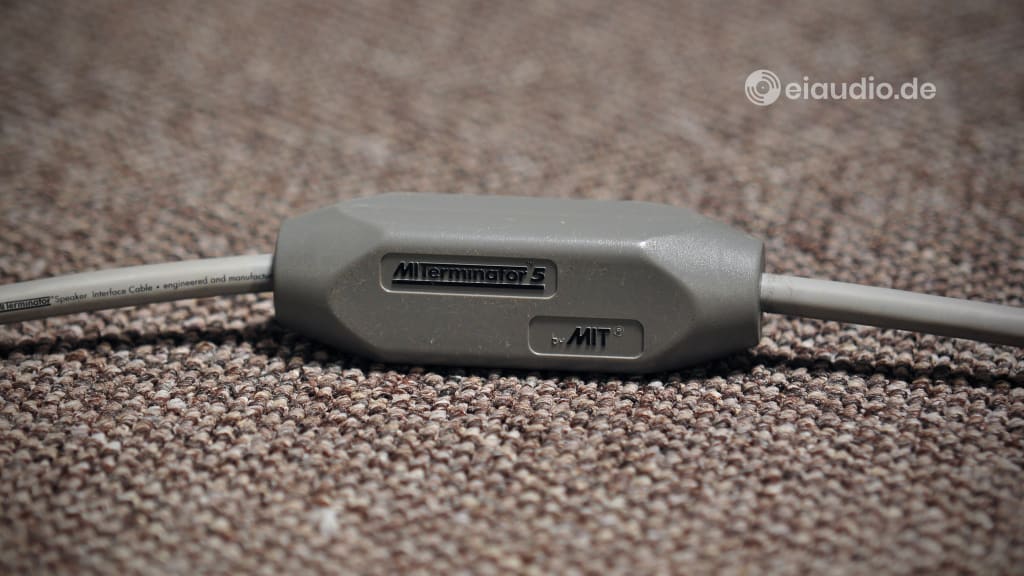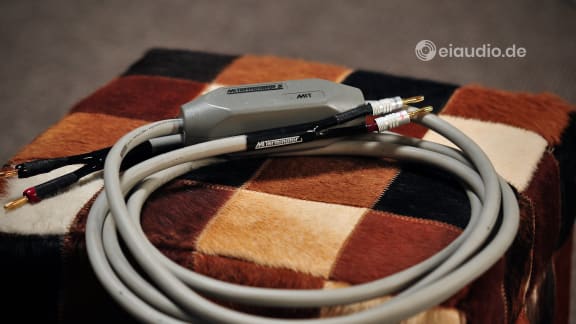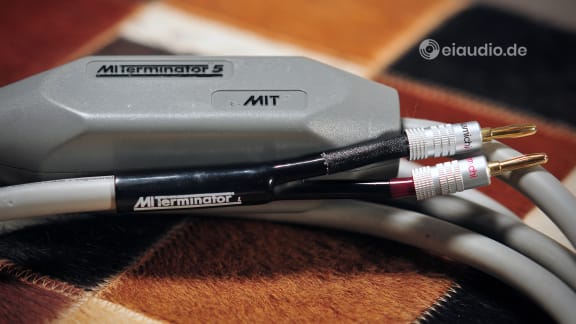MIT Terminator 5
Published: 06/06/2024
Manufacturing date: 1995
Author: Karsten Hein
Category: Gear & Review
Tag(s): Speaker Cables
The innovative MIT cable company is based in Reno, Nevada. And, although their acronym is the same, there is no relation with the world-renowned Massachusetts Institute of Technology. Much rather, the cable company’s letters stand for “Music Interface Technology”. Bruce Brisson, the head and master mind of MIT, is most famous for his research on how to eliminate the typical comb filter effects on signal cables. The Terminator 5 speaker cables were launched in the mid 1990s and already employ MIT’s patented multi-pole network technology.
The Terminator 5 offer a single-wire design that measures an impressive 12 mm in diameter. The specimens given to me for testing measured 3.60 m in length, with the network box (14 cm in length) starting at 2.60 m distance from the amplifier or 2.46 m from the loud speakers. With the signal direction indicated by small arrows running along the sides of the cables, the network box must be placed closer to the speakers than the amplifier. In most setups, the trademark network box with logo will therefore be visible somewhere in the open space between the loudspeakers and the HiFi system that drives them.
I first listened to the Terminator 5 cables perform at Matthias’ house when auditioning his Duevel Bella Luna loudspeakers. He was driving his omnidirectional horn speakers with a Devialet Expert power amplifier, and one of the first things I noticed was a slight midrange compression that I primarily attributed to the horn drivers of the loudspeakers. It was only upon closer inspection of the system that I saw a loop having formed on one of the MIT wires, most likely due to a careless moment during their installation. We got rid of the loop, and the horn compression effect bothered me much less, although some minor traces of it still remained.
When Mattias upgraded his HiFi system from the Duevel Bella Lunas to their flagship Jupiter speakers, he also swapped his MIT Terminator 5 cables against more capable contenders. And, seeing that I was interested in the MITs, Mattias suggested that I take them to our new studio in Marne for a more thorough examination. I was thrilled to be given this opportunity and quickly agreed. After all, one year had passed since I first listened to the Bella Lunas, and I had since then come a long way in my own explorations. The new studio, especially, had given me the chance to explore the subject of sound more deeply than ever before.
In the cable test that followed, I compared and contrasted the MIT Terminator 5 with three other popular vintage brands: Mark Levinson’s HF-10 C, a Swiss-made 10 AWG multi-strand ultra-pure copper wire; Symphonic Line’s Harmonie HD; and Sommer Cable’s entry-level Elephant cables. All of them had previously been re-confectioned with gold-plated banana plugs to increase usability over the original spades. There is not much I can say about the quality of the (mostly solid prong) connectors other than to state that they were all free from visible wear and corrosion. The Sommer Cables were the only ones using hollow banana plugs, which happen to be my personal favourite when confectioning wires.
My listening setup consisted of a Restek V1 preamplifier with external “Kassel” power supply. The preamp had been upgraded with new caps and ops by Restek a few years earlier and had generally performed well since. The amplifier was Symphonic Line’s RG11 MK5 S. I used Symphonic Line’s “Das Schnelle” interconnect between my Cambridge DAC Magic and the preamp as well as an older Symphonic Line Harmony HD cable between the preamp and the power amplifier. The Sansui SR-525 direct drive turntable was connected via my own silver solid-core interconnects, which generally served well in this position.
Connecting the Terminator 5 to my Tannoy XT8f floor-standing loudspeakers, I noticed how positively solid the single-wire design makes these cables feel. The materials are highly durable and still looked great after more than 30 years of service. As none of the wires in my test were made for bi-wiring applications, I had re-fitted the Tannoy’s dual binding posts with bridges made of 4mm solid-core copper wires cut and stripped from home installation cables. I connected the speaker wires in the typical fashion for single-wiring, directly addressing Tannoy’s dual-concentric drivers and then running the bridge down to the bass units from there.
From my listening position, I enjoyed the sophisticated look of the MIT cables. The network box was placed on the carpet floor right next to the speakers with the Terminator branding being clearly visible. This was my most “modern”-sounding setup, as the Tannoys could offer lots of musical detail, and the Restek V1 preamplifier, too, contributed to an open and transparent sound. The RG11 MK5 S is a highly musical and exact amplifier offering superb dynamics as well as tonality. From my first impression, it did not sound quite as tonally dark and rich as the Symphonic Line RG9 integrated amp, which would again appeal to a more modern Zeitgeist. The Symphonic Line interconnects could be quite unforgiving of flaws, and it was good fortune that neither of the components had the tendency to sound harsh.
I played music from two CDs: The German “Stereo” magazine’s song compilation “Die Hörtest CD Volume IX” lent to me by Arndt Voss and Diana Krall’s “Only trust your heart”. Stereo magazine’s CD offered the greater recording quality and more variety in the songs, however, I knew Diana Krall’s CD better, which allowed me to comment more accurately on tonality. On my Sansui turntable, I played Jazz albums by Helge Lien in order to have an alternative yardstick to the CD player and DAC. The MIT cables were the first specimens I auditioned in my test. I turned on the RG11 MK5 S and felt the reassuringly solid clang of the new Super-transformer being magnetised, long before the relays clicked in to engage the loudspeakers. I believe, there is no sensation quite like the buzz of powering up this amp.
Eduard Strauss’ “Bahn frei Polka” is a classical music piece performed by a large orchestra, and I was quickly reminded how important correct tonality is in maintaining order in multi-layered music. The MIT Terminator 5 supported the clean presentation by keeping a dark background. This assured an ordered and sophisticated sound. On Scotty Wright’s “Sound of Silence” I noticed the MIT’s midrange-focus and clarity that was topped off by a soft and silky treble. The singer did appear a little smaller than was otherwise usual on this system, and there was also that sensation of squeakiness again, which I had previously encountered when visiting Matthias. This was especially noticeable on female vocals, as I experienced with Tokunbo’s song “New June” but also when listening to Diana Krall's performances. I examined my system to see if either of the cables had accidentally become entangled behind the rack, but I could find no such fault.
In addition to the slight compression of the midrange, I could detect a bass hump in the area of 100-150 Hz. While this had worked well with Matthias’ Jupiter speakers, it did lead to occasional resonances in my listening setup. California Project’s song “Wouldn’t it be nice” starts with an ultra-loud drum beat. In combination with the Terminator 5 cables, I must confess that I almost fell off my chair. Dynamics in the kick-bass frequency range were truly beyond the ordinary, and none of the other cables packed such punch in this category. The MIT offered a super-wide stage impression and superb instrument separation on an otherwise black stage. This characteristic was supported by their ultra-quick sonic decay. I also noticed a preference towards warm and wooden tones. Tonality therefore was a bit more confined and not quite on par with some of the best (but also more expensive) cables I have heard.
Despite being more than 30 years old, MIT’s Terminator 5 provided an enjoyable and engaging listening experience with a sophisticated presentation. Their slight lack of tonal accuracy might easily be forgiven, considering the many advantages the cables offer. Among these were: Superb dynamics, a generous stage width, the physical separation of instruments from left to right (not so much tonally), a leaning towards pleasantly warm wooden tones. They were also capable of surprisingly low bass, whenever this was provided by the source material. The cable fits music genres that is fast and punchy, such as electronic music, Pop, Rock, etc. Due to its tweaked tonality, it would probably not be the first choice for listeners with a preference for Classical music, Vocal Jazz, or Singer Songwriter, unless it is able to balance out existing system flaws leading in the opposite direction.
Specifications
- Type: Single-wire loudspeaker cable
- Directional: Yes. Indicated by arrow.
- Length tested: 3.60 m (per channel)
- Termination tested: Nakamichi banana plugs
- Cable diameter: 12 mm
- Compensation: via network box




